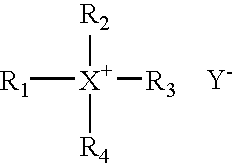Rapid-response reversible dry surface CO2 detector
a co2 detector and rapid response technology, applied in the field of dry surface co2 detectors, can solve the problems of false positive initial test for proper intubation, dangerous situation, and rare false positive initial indication regarding the success of intubation, and achieve the effects of excellent resistance to humidity, speed of color change, and intensity of color chang
- Summary
- Abstract
- Description
- Claims
- Application Information
AI Technical Summary
Benefits of technology
Problems solved by technology
Method used
Image
Examples
example 1
[0117]1 g Triton X-15 Octylphenol ethoxylate, was combined with 0.15 g KOC(CH3)3, 0.01 g Thymol Blue (supplied by Acros), and 50 ml ethanol. The mixture was heated to a boil. The solvent was then removed by boiling off to obtain a total volume between 5 and 10 ml. Using a cotton ball, the resulting solution was applied to the surface of a Supor® polyethersulfone filter strip and air-dried. The result was a solid, CO2 detector which changed from blue to yellow upon exposure to 5% CO2 concentration and reverted to blue upon re-exposure to ambient (˜0.03%) CO2 concentrations (i.e. a reversible CO2 detector). During the peak of functionality, the overall color change, based on change of hue, change of luminosity and speed of color change, was moderate (rated 7 on a scale of 1 to 10). The rate of substantially complete change of color was on the order of 180 one-way changes / minute (i.e. 90 back and forth cycles / minute). The detector was not highly humidity resistant, remaining functional...
example 2
[0119]A formulation was prepared using Polyethylene glycol 400, Thymol blue (supplied by Sigma Aldrich) and methanol. The solution was pH adjusted with 0.1 M aqueous KOH (supplied by JT Baker) until a blue solution was obtained. A polyethersulfone filter strip dipped in the solution and then dried resulted in a sample which showed a very rapid reversible color change to yellow upon exposure to 5% CO2. However, after sitting overnight, the sample was non-functional and a freshly prepared sample showed decreasing activity throughout the day.
example 3
[0120]1 g Triton RW-20 Alkylamine Ethoxylate, 0.24 g 30% NaOCH3 in methanol, 0.01 g Thymol Blue (supplied by Acros), and 30 ml ethanol were combined. The mixture was heated to a boil. The solvent was then removed by boiling off to obtain a total volume between 5 and 10 ml. Using a cotton ball, the resulting solution was applied to the surface of a polyethersulfone filter strip and air-dried. The result was a solid, reversible CO2 detector that changed from blue to yellow upon exposure to 5% CO2 concentration and reverted to blue upon re-exposure to ambient CO2 concentrations. During the peak of functionality, the overall color change, based on change of hue, change of luminosity and speed of color change, was moderate (rated 7 on a scale of 1 to 10). The rate of substantially complete change of color was on the order of 180 one-way changes / minute. The detector was not highly humidity resistant, remaining functional for less than a half hour at 100% humidity, gradually becoming non-f...
PUM
| Property | Measurement | Unit |
|---|---|---|
| pH | aaaaa | aaaaa |
| pH | aaaaa | aaaaa |
| time | aaaaa | aaaaa |
Abstract
Description
Claims
Application Information
 Login to View More
Login to View More - R&D
- Intellectual Property
- Life Sciences
- Materials
- Tech Scout
- Unparalleled Data Quality
- Higher Quality Content
- 60% Fewer Hallucinations
Browse by: Latest US Patents, China's latest patents, Technical Efficacy Thesaurus, Application Domain, Technology Topic, Popular Technical Reports.
© 2025 PatSnap. All rights reserved.Legal|Privacy policy|Modern Slavery Act Transparency Statement|Sitemap|About US| Contact US: help@patsnap.com



